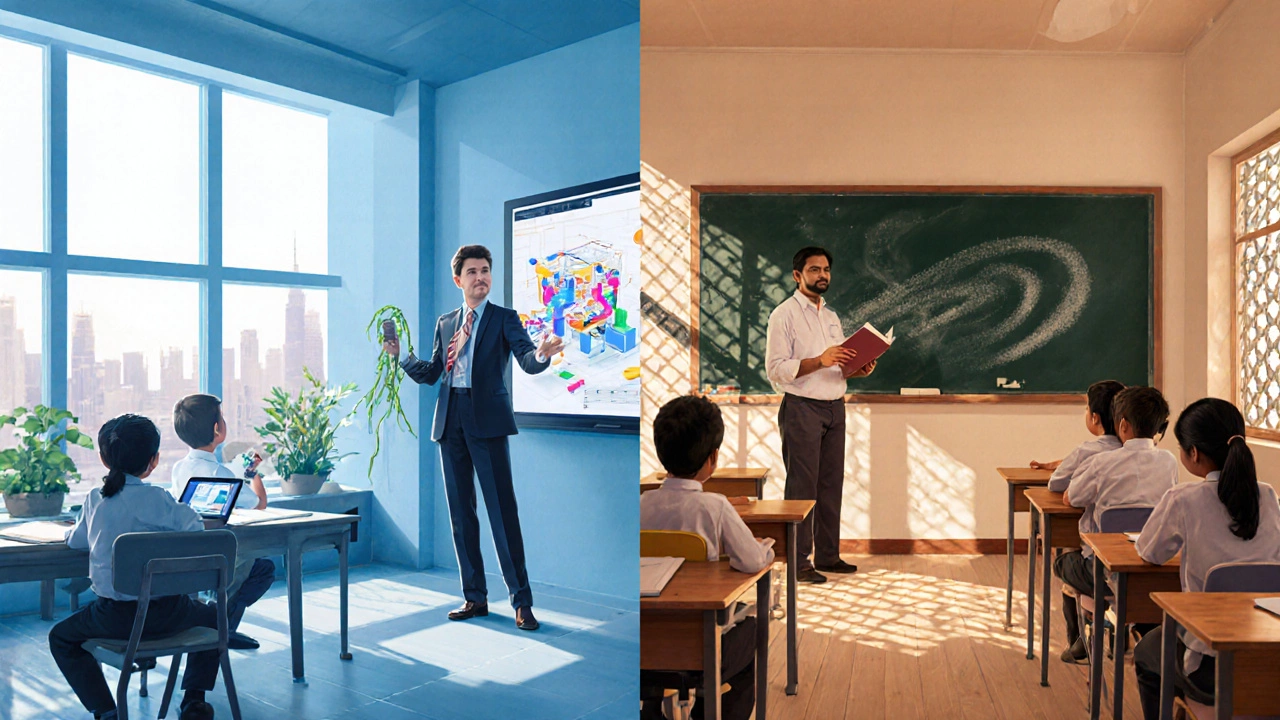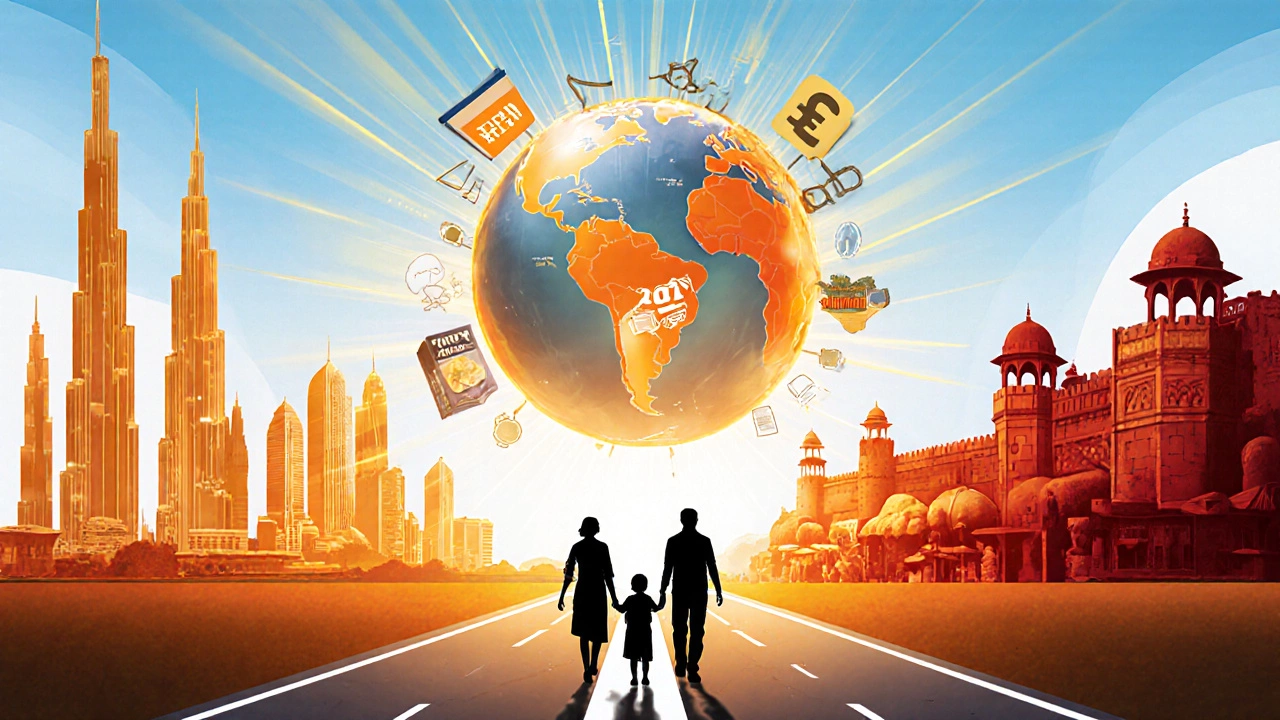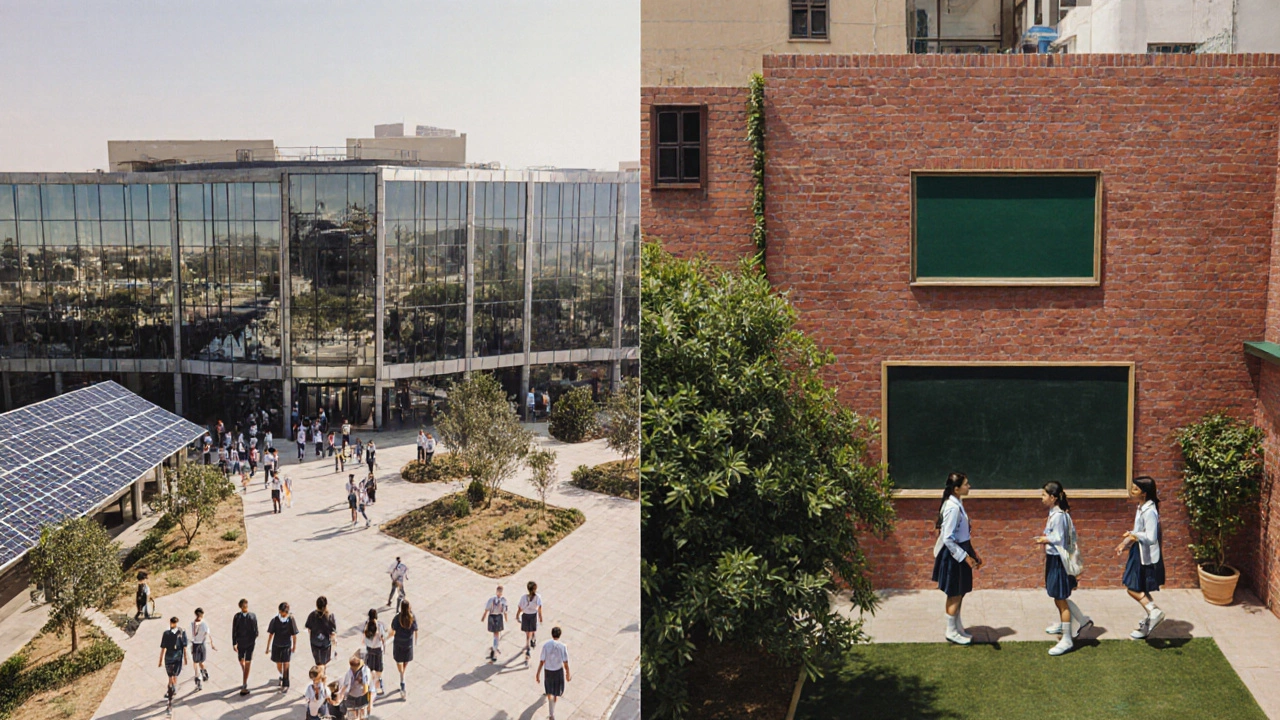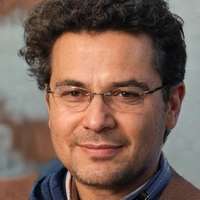Dubai vs India Education Comparison Tool
- Blended public, private, and international schools
- Curricula: GCSE, A-Level, IB, UAE Ministry
- High infrastructure investment
- Strong emphasis on STEM and critical thinking
- International recognition
- Largest education system globally
- Boards: CBSE, ICSE, State Boards
- Heterogeneous infrastructure
- Strong STEM focus with regional diversity
- Large talent pool for competitive fields
Click "Compare Systems" to see which education system aligns better with your priorities and budget.
When families weigh options for schooling or university, the question often bubbles up: Dubai education or Indian education - which offers better outcomes? This article unpacks the two systems across key dimensions - curriculum, teaching quality, infrastructure, costs, and global recognition - so you can decide based on facts, not hype.
What is the Dubai education system?
The Dubai education system is a blend of public, private, and international schools overseen by the Knowledge and Human Development Authority (KHDA). It hosts a mix of curricula - British GCSE/A‑Levels, American AP, International Baccalaureate (IB), and locally‑adapted UAE Ministry programs. The city also nurtures a fast‑growing higher‑education sector with universities such as the American University in Dubai (AUD) and the University of Dubai, many of which hold international accreditations.
What is the India education system?
The India education system is one of the world’s largest, spanning government‑run schools, private institutions, and a sprawling network of higher‑education colleges. Core school boards include CBSE, ICSE, and various state boards, while higher education features institutes like IITs, AIIMS, and numerous private universities. English and regional languages both serve as mediums of instruction, reflecting the country’s linguistic diversity.
How do the curricula compare?
Curriculum design shapes learning depth and future mobility. Below is a side‑by‑side look at the most common tracks.
| Aspect | Dubai | India |
|---|---|---|
| Primary Frameworks | British (GCSE), American (AP), IB, UAE Ministry | CBSE, ICSE, State Boards, IB (limited) |
| Assessment Style | Mixed - coursework, exams, continuous assessment | Heavy reliance on final exams, especially in Class 10 & 12 |
| Global Transferability | High - most curricula are internationally recognized | CBSE/ICSE are recognized, but many state board results need conversion |
| Focus Areas | STEM, critical thinking, multilingualism | Strong emphasis on STEM, but with less focus on soft skills |

Teacher qualifications and professional development
Teacher qualifications differ markedly. In Dubai, KHDA mandates that at least 70% of teachers hold a recognized teaching degree and undergo annual professional‑development credits. Schools often bring in expatriate educators with experience from UK, US, or Australia, and they receive regular performance reviews.
In India, teacher eligibility is set by the National Council for Teacher Education (NCTE) for schools and by university statutes for higher education. While many teachers hold a B.Ed., the enforcement of continuous training varies; rural schools may have less access to up‑skilling programs compared to elite private schools.
Infrastructure and learning environment
Infrastructure can boost engagement. Dubai schools typically invest heavily in modern campuses - smart boards, labs, sports complexes, and safety‑first designs mandated by KHDA. For example, the Dubai International Academy boasts a purpose‑built robotics lab and an indoor sports arena.
India’s infrastructure is heterogeneous. Elite private schools in metros often match global standards, but government schools in many states still lack basic facilities like adequate toilets or stable electricity. The Student‑Teacher Ratio in Dubai averages around 1:15, whereas in India it ranges from 1:30 in private schools to 1:45-1:60 in public schools.
Cost of education
Affordability matters. Annual tuition for a Dubai private school can range from USD 6,000 to USD 30,000, depending on curriculum and facilities. Higher‑education fees for international‑accredited programs sit between USD 12,000 and USD 25,000 per year.
In India, tuition for CBSE/ICSE private schools usually falls between INR 30,000 and INR 250,000 (USD 350‑3,000). Top‑tier private colleges charge INR 500,000-1,500,000 (USD 6,000‑18,000) annually, while government institutions are substantially cheaper, often below USD 1,000 per year. Scholarships and government aid can offset costs in both countries, but the overall spending gap remains sizable.

Student outcomes and global rankings
Outcome metrics include exam performance, university placement, and employability. Dubai’s students consistently rank well in PISA assessments for expatriate school cohorts, especially in reading and mathematics. Moreover, UAE graduates benefit from fast‑track visa policies that attract global employers.
India produces a massive talent pool. IIT and AIIMS graduates regularly appear in global university rankings and secure high‑salary tech jobs abroad. However, average public‑school outcomes lag behind, with national PISA scores often below the OECD average.
Which system suits different goals?
- International mobility: Families aiming for seamless university transfers abroad may favor Dubai’s internationally aligned curricula.
- Cost‑sensitive families: Indian private schools offer quality at a fraction of Dubai’s tuition, especially when leveraging local scholarships.
- STEM specialization: Both systems excel, but Dubai’s modern labs and industry partnerships can give an edge for hands‑on research.
- Cultural immersion: Dubai provides a multicultural environment with 200+ nationalities, while India offers deep cultural roots and regional language exposure.
Ultimately, “better” hinges on the learner’s priorities - financial, academic, or cultural.
Common pitfalls to watch out for
- Assuming a high tuition automatically guarantees top‑notch education - research school inspection reports (KHDA in Dubai, CBSE/Affiliation data in India).
- Overlooking language support - Dubai’s English‑dominant instruction may challenge students from non‑English backgrounds; Indian schools may require proficiency in regional languages.
- Neglecting accreditation - ensure the institution holds international accreditations (e.g., AACSB for business schools, NAAC for Indian universities).
- Ignoring post‑graduation work‑visa policies - Dubai offers 2‑year residence permits for graduates; India’s job market is competitive and often regional.
Frequently Asked Questions
Is the Dubai curriculum easier than India’s?
Difficulty varies by curriculum. British A‑Levels or IB in Dubai are comparable to CBSE’s 12th‑grade board exams. Both demand strong study habits; the perceived ease often ties to teaching style and assessment format rather than inherent rigor.
Do Indian universities accept Dubai school certificates?
Yes. Most Indian universities recognise IB, Cambridge IGCSE, and A‑Level results. CBSE or state‑board equivalence may require additional conversion, but the process is well‑established.
What are the visa implications for studying in Dubai?
Students receive a study visa valid for the duration of their program, with the possibility of a 2‑year post‑graduation residence permit if they secure a job in a UAE‑based company.
How does teacher quality differ between the two countries?
Dubai enforces stricter expatriate‑teacher vetting and continuous professional‑development. India has a large pool of qualified teachers, but consistency varies, especially in rural public schools.
Which system offers better career prospects?
Career prospects depend on the field. Dubai’s proximity to fast‑growing sectors like finance and tourism can fast‑track graduates into multinational roles. India’s tech and healthcare sectors provide vast opportunities, especially for engineers and doctors.

